by
Brian Dunning, Jan 19 2012
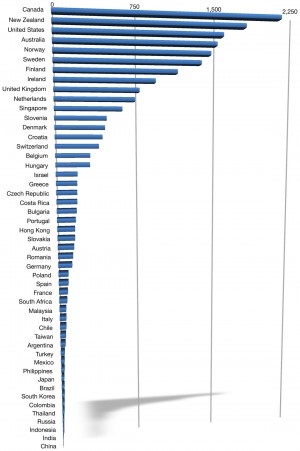 So the other day I asked our goodly site admin William Bull for some stats by country, eager to see how it compares with Skeptoid podcast listener distribution. Turns out it’s pretty close. This graph (click to see full size) shows SkepticBlog.org page views over the past year per million of each population’s country. So it’s a fair indicator of this blog’s relative popularity in each country. (Any countries not listed had fewer than one page view per million population.)
So the other day I asked our goodly site admin William Bull for some stats by country, eager to see how it compares with Skeptoid podcast listener distribution. Turns out it’s pretty close. This graph (click to see full size) shows SkepticBlog.org page views over the past year per million of each population’s country. So it’s a fair indicator of this blog’s relative popularity in each country. (Any countries not listed had fewer than one page view per million population.)
Obviously this is an English language blog written by primarily American authors, so we cannot extrapolate this data to indicate the relative popularity of skepticism in general in each country. But there are two surprises. Continue reading…
comments (54)
by
Donald Prothero, Dec 07 2011
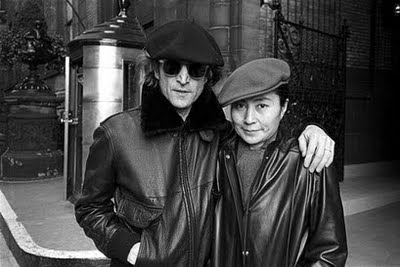 <
<
Imagine there’s no Heaven, it’s easy if you try, No hell below us, above us only sky, Imagine all the people, living for today.
Imagine there’s no countries, It isn’t hard to do, Nothing to kill or die for, and no religion, too, Imagine all the people, living life in peace.
—John Lennon, Imagine, 1971
As this post goes live, I’m doing museum work at the American Museum of Natural History in New York. Whenever I travel to New York City, there are certain places on the Upper West Side (where I lived for 6 years completing all my graduate degrees at Columbia University) that I always return to, just see how the city has changed, and relive memories. One of these is the Dakota Apartment Building, on the corner of 72nd Street and Central Park West. It has a long and famous history, from its origin as a unique building for the rich in the 1880s, to its use as a movie exterior (especially in Rosemary’s Baby and Cruel Intentions), to the many legends who have lived there: Lauren Bacall, Leonard Bernstein, Connie Chung, Rosemary Clooney, Roberta Flack, Jose Ferrer, Judy Garland, Lilian Gish, Boris Karloff, Rudolf Nureyev, Jack Palance, Gilda Radner, Rex Reed, Jason Robards, and Robert Ryan, among many others. Not every star can live there; some, like Billy Joel, Gene Simmons, Melanie Griffith, and Antonio Banderas, were denied residency by the governing board. But one resident of that building is more famous than the others, especially because he died on its doorstep.
Tomorrow, Dec. 8, 2011, will be the 31st anniversary of the day that Mark David Chapman gunned down John Lennon in the doorway of the Dakota (the doorway is shown to the right of Yoko Ono in the picture at the top) just as he and Yoko Ono were returning from a late recording session. I remember that event vividly, because I was just five blocks away at the time it happened. I was working very late that night, finishing research on my dissertation at the American Museum of Natural History at the time, and even had an office on the southeast corner of the building (near the corner of Central Park West and 77th St). If it hadn’t been winter and my windows had not been closed, I might have even heard the gunshots. Back then, there was no internet or 24-hour news on your iPhone, so I went home about midnight not knowing he’d been shot around 10:50. The news was still reported by TV newscasts and the newspapers—but I didn’t have a TV when I was a poor grad student in New York, and the papers didn’t have the news until next morning so I didn’t hear about it until I woke up and hit the streets and saw the news on every newsstand.
I immediately rushed to the Dakota, where a huge crowd of mourners had gathered, and flowers, candles, and tributes were stuffed into every part of the fence around the building. I couldn’t stay with the mourners all day, but it was amazing to see how deeply John had reached so many people. The vigil outside the Dakota lasted for days, until eventually it was called off at Yoko Ono’s request. In 1985, Mayor Ed Koch renamed the adjacent part of Central Park (which John and Yoko could see from their windows) “Strawberry Fields” and there is a mosaic memorial plaza there with the word “Imagine” that is nearly always decorated with flowers, guitars, candles, and other tributes, even 30 years later.
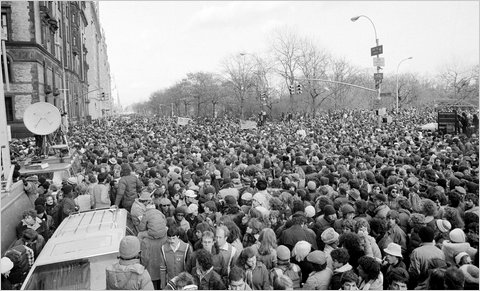
Continue reading…
comments (69)
by
Daniel Loxton, Apr 26 2011
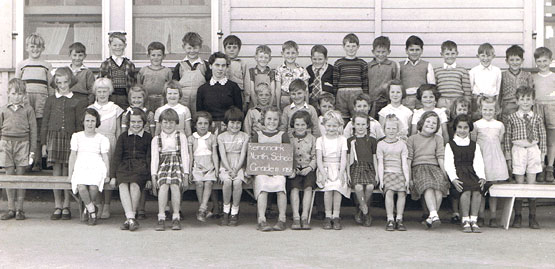
Renmark North School, Grade 2, 1956. South Australia. Photo provided by Bonnie Poulter
[This week, I'd like to share a story excerpted from my recent LogiCON keynote. The speech is a bit on the personal side, as I'm sure you'll be able to tell. Much of it has to do with my own childhood. —Daniel]
My father has always been a wonderful storyteller.
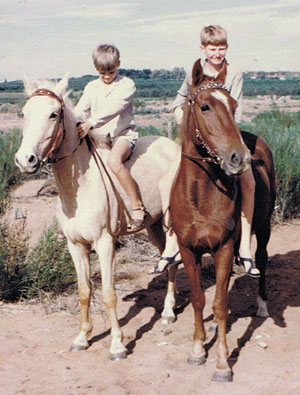 When my brothers and I were little, my Dad would tuck us into our beds, “bristle” our cheeks with his stubble, and tell us stories or poems. We loved Australian bush poetry (we must have heard “Mulga Bill's Bicycle” and “The Man From Ironbark” a thousand times), but our favorites were tales of his own childhood, growing up poor on the edge of the desert in South Australia. His Tom Sawyer-like childhood sounded magical to us: racing horses bareback over red sand, plucking oranges from the trees of his family's tiny fruit farm, catching yabbies in the hidden backwaters of the River Murray.
When my brothers and I were little, my Dad would tuck us into our beds, “bristle” our cheeks with his stubble, and tell us stories or poems. We loved Australian bush poetry (we must have heard “Mulga Bill's Bicycle” and “The Man From Ironbark” a thousand times), but our favorites were tales of his own childhood, growing up poor on the edge of the desert in South Australia. His Tom Sawyer-like childhood sounded magical to us: racing horses bareback over red sand, plucking oranges from the trees of his family's tiny fruit farm, catching yabbies in the hidden backwaters of the River Murray.
Many of these stories had a subversive edge to them, I realize now. Many were direct lessons in skepticism.
Continue reading…
comments (22)
by
Michael Shermer, Oct 12 2010
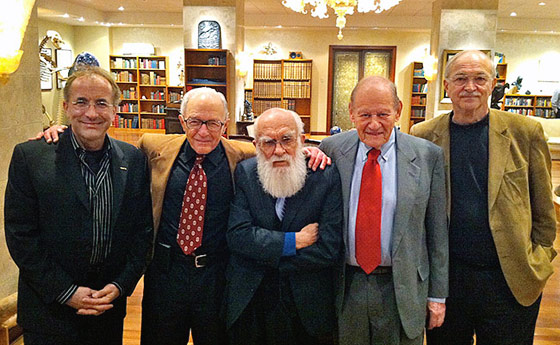
Skeptical Luminaries right to left: paranormal investigator Joe Nickell, Center for Inquiry founder Paul Kurtz, the Amazing One himself, and psychologist and magician Ray Hyman
On Sunday, October 3, a group of skeptics gathered in Falls Church, Virginia to celebrate James Randi’s 82nd birthday. What an amazing meeting it was … er, an astonishing evening I mean, as Randi prefers to retain the “amazing” adjective for his moniker, James “The Amazing” Randi. Take a look at just a few of the giants present in the above photo — the legends of skepticism (from right to left: paranormal investigator Joe Nickell, Center for Inquiry founder Paul Kurtz, the Amazing One himself, and psychologist and magician Ray Hyman). Continue reading…
comments (28)
by
Daniel Loxton, May 25 2010
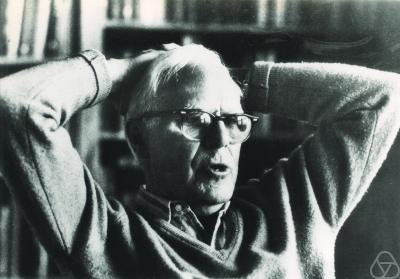
Martin Gardner portrait by Konrad Jacobs. Courtesy Oberwolfach Photo Collection
By now you will most likely have heard the sad news of the death of Martin Gardner — the father of modern skepticism — at age 95. He was, as his friend James Randi wrote, “a very bright spot in my firmament.”
Many people feel the same way, and for good reason. Gardner’s impact cannot be overstated. It is fair to argue that Martin Gardner created the modern skeptical literature from whole cloth. His 1952 book In the Name of Science (retitled Fads & Fallacies in the Name of Science for the second and subsequent editions; hereafter referred to as Fads & Fallacies) set the standard that later led to the creation of CSICOP — and to all that has followed since. Through his books and his “Notes of a Fringe-Watcher” column in the Skeptical Inquirer, Martin Gardner was a meticulous skeptical scholar for six decades. (Amazingly, his most recent Skeptical Inquirer articles appeared earlier this year.) Continue reading…
comments (20)
by
Daniel Loxton, Feb 16 2010
In November of 2007, I heard that an alleged energy healer named Adam McLeod (“Adam Dreamhealer”) was scheduled to appear on a popular Canadian Broadcasting Corporation talk show, The Hour with George Stroumboulopoulos. I was familiar with the Adam Dreamhealer case, and also uncomfortably aware that media outlets usually treat miracle healers as harmless, untestable human interest stories. I was concerned about the ethical implications of promoting Adam’s claims to a national television audience. (Adam claims abilities for “energetically diagnosing illnesses,” and treating cancer “from 3000 miles away.” According to his web site, Adam is “uniquely able to influence the health and healing of large groups of individuals at his workshops by joining the auras of all in attendance.”)
I wrote to the producers of the show in advance to offer my assistance, and to remind them, “When The Hour interviews Adam, there will no doubt be thousands of viewers who are either suffering from cancer or watching a loved one suffer from cancer — all potential customers” of Adam’s lucrative books and healing workshops. (According to ABC News, then-19 year old Adam was already making over a million dollars a year in 2006.) Continue reading…
comments (103)
by
Michael Shermer, Sep 15 2009
On Saturday, September 12, after flying 17 hours from Cluj, Romania to Budapest, Hungry to Zurich, Switzerland to L.A.X., I drove straight to the Queen Mary in Long Beach, where there was a big paranormal conference hosted by Dave Schrader of Darkness Radio. Dave is a very open-minded fellow, in the sense that he thought it might behoove his flock to have them hear what scientists think some plausible natural and normal explanations there are for the various supernatural and paranormal phenomena that his members tend to believe in and talk about at such conferences (there was even a ghost hunting expedition on the Queen Mary later that night, but I was wasted from flying for so long and passed on being spooked on the ship). Continue reading…
comments (35)
by
Michael Shermer, Jul 28 2009
So many of you have taken the time to respond to my blogs thoughtfully that I feel I should comment in kind. In looking through the many comments, however, I see that most of what I would say has already been said by people who responded to my critics. Nevertheless…
First of all, why is it okay to mix science and religion (with atheists eagerly do in debunking religious claims) but not okay to mix science and politics/economics? Why is it okay for liberal atheists to stick it to religious believers and twist the knife slowly, but when it comes to getting your own (political/economic) beliefs challenged, that’s off limits — NOMA (nonoverlapping magisterial) for science and politics? I don’t see how they are different in principle. Skeptic is a science magazine, not an “atheist” magazine; nevertheless, we routinely deal with religious claims and no one ever complains about that. The closest we have come to political/economic issues is environmentalism (Vol. 9, No. 2 — sold out), overpopulation (Vol. 5, No. 1), and global warming Vol. 14, No. 1). For all three we published several articles; in Vol. 14, No. 1, for example, we published articles both skeptical of global warming and accepting of global warming. So I don’t see what would be wrong with publishing articles pro, con, and neutral on political and economic claims. Continue reading…
comments (266)
by
Kirsten Sanford, Jul 24 2009
Last week my friend sent me a picture of a flyer he had seen on the street. It didn’t seem like much at first glance — just some hokum woo — but, on further investigation (because of course you have to investigate hokum woo!) it opened up a whole world of intrigue.
The flyer was for the ‘Vital Orbit™’ Personal Human Force Field.
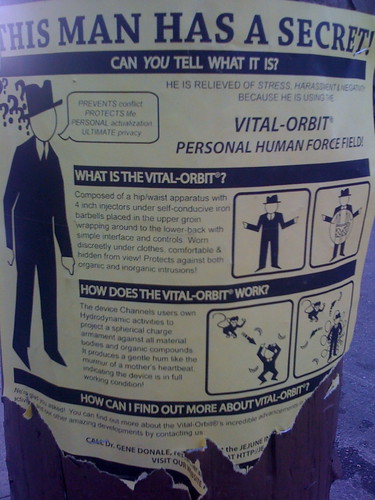
Personal Human Force Field - note that all the contact tags have been removed
Continue reading…
comments (15)
by
Kirsten Sanford, Jun 26 2009
People believe the strangest things. Usually it’s because they learned it as a child, and never stopped to question the validity of the belief.
When that belief is questioned by someone else it can be perceived as an attack not only on their intelligence, but also on the people from whom they first learned the information in question. Questioning beliefs picks away at the mentors and heroes from a person’s upbringing. Continue reading…
comments (86)
 So the other day I asked our goodly site admin William Bull for some stats by country, eager to see how it compares with Skeptoid podcast listener distribution. Turns out it’s pretty close. This graph (click to see full size) shows SkepticBlog.org page views over the past year per million of each population’s country. So it’s a fair indicator of this blog’s relative popularity in each country. (Any countries not listed had fewer than one page view per million population.)
So the other day I asked our goodly site admin William Bull for some stats by country, eager to see how it compares with Skeptoid podcast listener distribution. Turns out it’s pretty close. This graph (click to see full size) shows SkepticBlog.org page views over the past year per million of each population’s country. So it’s a fair indicator of this blog’s relative popularity in each country. (Any countries not listed had fewer than one page view per million population.)
 <
<

 When my brothers and I were little, my Dad would tuck us into our beds, “bristle” our cheeks with his stubble, and tell us stories or poems. We loved Australian bush poetry (we must have heard “Mulga Bill's Bicycle” and “The Man From Ironbark” a thousand times), but our favorites were tales of his own childhood, growing up poor on the edge of the desert in South Australia. His Tom Sawyer-like childhood sounded magical to us: racing horses bareback over red sand, plucking oranges from the trees of his family's tiny fruit farm, catching yabbies in the hidden backwaters of the River Murray.
When my brothers and I were little, my Dad would tuck us into our beds, “bristle” our cheeks with his stubble, and tell us stories or poems. We loved Australian bush poetry (we must have heard “Mulga Bill's Bicycle” and “The Man From Ironbark” a thousand times), but our favorites were tales of his own childhood, growing up poor on the edge of the desert in South Australia. His Tom Sawyer-like childhood sounded magical to us: racing horses bareback over red sand, plucking oranges from the trees of his family's tiny fruit farm, catching yabbies in the hidden backwaters of the River Murray.

